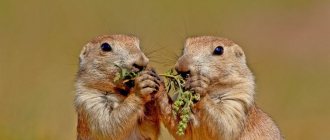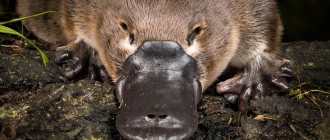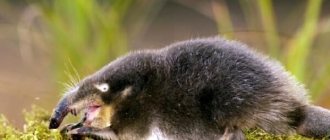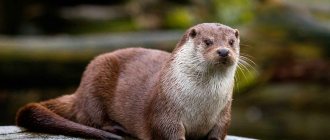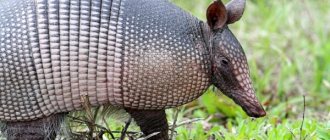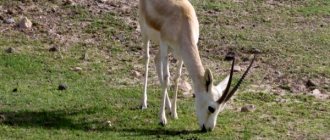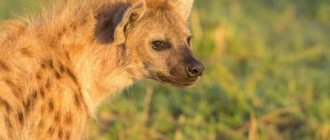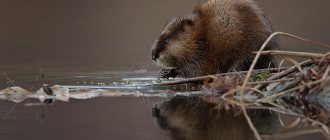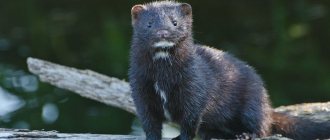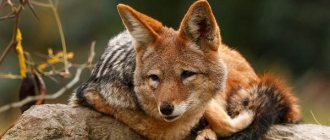The gopher is a small rodent, a representative of squirrels, a pest and carrier of plague, tularemia and brucellosis. Due to the significant damage that this animal can cause to farmland, it is constantly hunted for varmint - sport hunting.
The animal, communicating with its relatives, constantly makes peculiar sounds. It was this feature that formed the basis for the name of the small rodent. In the Old Church Slavonic language the word “susati” means “to hiss.”
Description of the gopher
The body size of the animal varies from 16 to 26 cm, especially large individuals can reach 39 cm. Sexual dimorphism is observed among gophers: females are always lighter and smaller than males. The weight of rodents can reach 1500 grams, but in most cases the animal weighs about 190 g.
The hind legs of the gopher are slightly longer than the front ones. There are sharp, strong claws on the limbs that help rodents dig holes.
The animals' heads are small and elongated. The ears look a little underdeveloped. They are covered with a small fluff. The eyes are small with well-developed lacrimal glands. Thanks to this, the cornea is reliably protected from dust.
The structure of the jaw allows rodents to dig holes without swallowing soil. Some representatives of marmots have well-developed cheek pouches. They enable the animal to carry food into the hole.
The presence of gophers in the field can be easily determined by whistling. Animals, standing on their hind legs, constantly squeak. Peculiar voice signals are heard first from one side, then from the other. Thus, a family of rodents communicates with each other, informing members of their group about danger and the availability of food.
Depending on the species, the tail of an animal can be from 4 to 26 cm in length. Sometimes it is almost equal in size to the body. The tail in rodents performs a number of functions:
- in the steppe, to prevent overheating, the animal covers itself with it like an umbrella;
- in a hole, the gopher feels the walls with it, thus orienting itself in space;
- In winter, a sleeping gopher is covered with it like a blanket.
In the warm season, the animal’s fur is coarse, short, and not thick. When it gets cold, it becomes very soft and fluffy. Depending on the habitat, the color of the animals’ backs also changes. It can be with dark stripes, speckled, sandy, brown, greenish. The abdomen is most often yellowish or white.
Interesting Facts
At first glance, gophers are ordinary and unremarkable rodents. But their behavior and social structure can surprise even skeptical people.
Interesting Facts:
- If a snake attacks a nesting hole, the female stands up to protect her offspring, regardless of the danger. She blocks the entrance to the hole, screams, waves her tail and makes throws towards the snake. Even after being bitten, the female continues to protect her children and bravely rushes at the enemy.
- Young gophers are the last to fall asleep. Adult males are the first to go into hibernation.
- Adult gophers develop immunity to snake venom.
- The territory of the colony is always protected by gopher guards. When danger arises, the animals emit a piercing whistle, which serves as a signal to other animals.
- Gophers talk to each other using different volumes and tones, sometimes barely audible to humans. So one animal can inform another about danger or mark its territory.
- During hibernation, gophers fall into a deep sleep. In this state, some subspecies are able to survive sub-zero temperatures.
- Some subspecies can hibernate up to 9 months of the year.
- Caring mothers build additional burrows for growing offspring near feeding areas.
- The mouth of gophers is protected by folds of skin that prevent soil from entering the oral cavity while digging holes.
- The smallest gopher weighs only 150 g, and the largest member of the family can gain weight up to one kilogram.
Where does the gopher live?
The gopher lives in temperate latitudes. It can be found in the forest-tundra and steppes of the Northern Hemisphere. Most often, the rodent prefers to settle in open landscapes.
The animal leads a terrestrial lifestyle. It independently digs holes, the length of which depends entirely on the soil. So, on sandy lands, it can reach 16 m, on clay lands no more than 8. Inside the hole there is often a nesting chamber, carefully lined with grass. Where the gopher lives, you can see sand mounds in front of the entrance.
Animals are active during the daytime. They rarely stray far from their burrow. Rodents settle in colonies of 19-29 individuals. Several gophers constantly guard near their burrows. If they see danger, they immediately signal the rest of the family. To protect their lives, rodents settle not far from animals similar to gophers - marmots. They also carefully monitor their surroundings and emit signals at the slightest threat. When danger appears, gophers stand on their hind limbs and whistle.
Habitat
Ground squirrel populations inhabit North America and are distributed throughout Eurasia. Basically, animals prefer to settle in the steppe, forest-tundra zones, meadows and fields. Some species live beyond the Arctic Circle, high in the mountains and even in deserts.
The animals are not afraid of people and often settle on the borders of agricultural land, near warehouses with grain and hay.
What do gophers eat?
What do gophers eat? Despite the fact that the basis of the diet of rodents is plant foods, their diet varies greatly depending on the species and habitat.
In mountainous areas, the animal feeds on 78 species of plants. Of these, 19 are annual, 49 are perennial, 7 are subshrubs. In spring, the rodent's diet includes the roots of Tien Shan onions, dandelions, knotweed, and tulips. When greenery appears, the upper shoots of plants are used for food.
In mid-summer, rodents eat grass and seeds of small-petaled zeravshan, dandelion, bluegrass, knotweed, geranium, and hollyweed.
Animals also eat mushrooms and berries, young willow branches and birchberries. The diet of gophers also includes animal food: insects, voles, and small birds. They do not disdain carrion.
During the experiment, it was found that in the presence of a sufficient amount of food, only lactating and pregnant females ate the corpses of other animals.
Ecology
Range and habitat
The striped ground squirrel is endemic to Ethiopia,[6], Kenya, Somalia, Sudan, Tanzania, Djibouti, Eritrea and Uganda and is probably extant in Somalia.[7] It's natural habitats include dry (arid) savanna and subtropical or tropical arid scrubland. The populations occupy many overlapping regions with their sister group, the striped ground squirrel ( X. erythropus
), in northeast Africa.[8]
X. rutilus
dig and occupy burrows in generally dry conditions.[3]
Diet and feeding
Rough ground squirrels exhibit diurnal behavior[3] with an omnivorous diet consisting of leaves, tree fruits (Adansonia digital), seeds (Commiphora and Acacia), other plant materials and insects.[3] Research[9] show it X. rutilus
is not affected by poisonous tannins and eats foods containing oxalic acid to some extent.
X. rutilus
has been shown to be uniquely effective in its ability to feed food. This ability is not impaired in a variety of environments, including those with poor or moderate food supplies.[9]
Gopher breeding season
After the females awaken from hibernation, the mating season begins. The breeding process is short. The mating season lasts about 11 days. However, in some cases its duration increases to a month.
Females give birth once a year. Their pregnancy lasts 29 days. Cubs are born in May.
There are 3-16 cubs in a litter. But most often the number of cubs does not exceed 9. The number of newborn marmots is directly dependent on the habitat and sufficient food.
Lactation in females lasts 33 days. Males do not take part in raising the young.
Cubs are born blind. Their eyes open 21 days after birth. After just 28 days, the young gopher begins to feed on grass and move around. However, he continues to feed on milk. Having grown stronger, the juveniles leave the burrows for the first time. After a few days, young gophers begin to look for a home not far from their family.
Small representatives of rodents reach sexual maturity by next spring. The inhabitants of the northern regions begin to reproduce only after several hibernations.
In the first year, 69% of the juveniles die. This is facilitated by predators and the late onset of spring.
Links[edit]
- ^ a b c d e Cassola, F. (2016). "Xerus inauris (revised version published 2022)". IUCN Red List of Threatened Species
.
2016
: e.T23145A115167437. Retrieved February 19, 2022 .CS1 maint: ref=harv (link) - Thorington, R.W., Jr.; Hoffman, R. S. (2005). "Family Sciuridae". In Wilson, Delaware; Reader, D. M. (ed.). Mammal Species of the World: A Taxonomic and Geographical Guide (3rd ed.). Johns Hopkins University Press. item 790. ISBN 978-0-8018-8221-0. OCLC 62265494.
- Foljambe, Alice Etheldreda Georgiana Mary (June 1903). Notes and comments - via Wikisource.
- ^ abcdefghij Skurski D., J. Waterman. 2005. “Xerus inauris,” Mammal Species
781: 1–4. - ^ abc Skinner J. D., R. N. Smithers. 1990. Mammals of the South African Subregion
, University of Pretoria. - Lynch CD 1983. "Mammals of the Orange Free State", Memoirs van die Nasionale Museum
18: 58-60. - ^ abcdef Zumpt IF 1970. "Gopher", African Wild Life
24: 115-121. - ^ abcdefghij Herzig-Straschil, Barbara (1977). "Towards the biology of Xerus inauris (Zimmermann, 1780) (Rodentia, Sciuridae)". Zeitschrift für Säugetierkunde
.
43
: 262–278. - ^ abcde Herzig-Straschil B. 1979. “ Xerus inauris
(Rodentia, sciuridae)—an inhabitant of the arid regions of southern Africa,”
Folia Zoologica
28: 119-124. - ^ abc Smithers RHN 1971. Mammals of Botswana
, Salisbury, Rhodesia, Museum Memoirs No. 4. - ^ abcdefgh Waterman, J.M. 1995. "Social organization of the Cape ground squirrel ( Xerus inauris
; Rodentia: Sciuridae)."
Ethology
101: 130–147. - ↑
Bennett, A. F., R. B. Huey, H. John-Alder, and K. E. Nagy.
1984. "Umbrella tail and thermoregulatory behavior of the Cape gopher ( Xerus inauris
)",
Physiological Zoology
57: 57–62. - Samson, Jamie; Manser, Martha B. (September 1, 2016). "Use of the sun as a directional indicator in caching and retrieval in wild rodents". Scientific reports
.
6
: 32570. Bibcode: 2016NatSR ... 632570S. DOI: 10.1038/srep32570. PMC 5007651. PMID 27580797. - ^ abc Waterman, J., J. Roth. 2007. “Interspecific associations of Cape ground squirrels with two mongoose species: benefit or cost?” Behavioral Ecology and Sociobiology
, 61(11): 1675-1683. - Belton, L., N. Ball, J. Waterman, P. Bay, African Zoology
, 42(1): 135-138. - ^ ab Waterman, J.M. 1997. "Why do male Cape Town ground squirrels live in groups?" Animal Behav
53:809–817. - Waterman, Jane M. (2006). "Maturity delay, group division, and group size limits in female Cape ground squirrels (Sciuridae: Xerus inauris
)".
Journal of Zoology
.
256
(1):113–120. DOI: 10.1017/S0952836902000146. - ^ abc Waterman, Jane M. (1998). "Mating tactics of male Cape ground squirrels Xerus inauris
: implications of year-round breeding."
Animal behavior
.
56
(2):459–466. DOI: 10.1006/anbe.1998.0780. PMID 9787037. - ^ abcd Waterman, Jane M. (1996). "Reproductive biology of the tropical, non-hibernating ground squirrel". Journal of Mammology
.
77
(1):134–146. DOI: 10.2307/1382715. JSTOR 1382715. - Waterman JM (2010). "The adaptive function of masturbation in the promiscuous African ground squirrel". PLOS ONE
.
5
(9):e13060. Bibcode: 2010PLoSO...513060W. DOI: 10.1371/journal.pone.0013060. PMC 2946931. PMID 20927404.
Hibernation of gophers
Hibernation in rodents lasts for six months. The gopher sleeps, sitting on its hind limbs, pressing its head to its abdomen and covering itself with its tail. During sleep, the animal loses half its weight. That is why it is so important that the animal accumulates a sufficient amount of fat during the warm season. Otherwise it may die.
Some time before hibernation, American ground squirrels begin to produce steroids in their bodies. Their number exceeds the average by 199 times. This allows you to increase muscle mass many times over. Experts have found that the adrenal glands help produce such amounts of hormones. An interesting fact is that in ground squirrels, under the influence of steroids, only muscle mass increases; other tissues are not affected.
With the onset of cold weather, rodents climb into their holes. The temperature there does not exceed zero degrees.
Winter is a real challenge for many animals. The sleeping gopher copes with frost thanks to anabolic hormones. During hibernation, the body's metabolism does not stop.
Accumulated fat does not provide the nutrition necessary for vital organs. The necessary glucose is synthesized from muscle proteins.
Animals hibernate not only because of the onset of cold weather. This is often caused by a lack of sunlight. The rodent body cannot cope with the winter cycle of night and day.
Once gophers enter their burrows, their circadian rhythms are blocked. Their body temperature at this time drops to -3°C. To prevent the blood from turning into ice, rodents clean it of all impurities that can freeze.
The duration of sleep of animals depends on their habitat. In the southern regions, hibernation is very short; in the northern regions it lasts up to six months.
Natural enemies
According to statistics, more than 70% of young animals die in the first year of life. In most cases, the causes of death are long winters, soil freezing, insufficient supplies in the pantry, anthropogenic factors and predatory animals.
In nature, gophers have a lot of enemies; they are hunted by all predatory animals and birds.
The main danger comes from foxes, ferrets, weasels, stoats, domestic dogs and hawks. Most predatory animals hunt gophers in the summer, but foxes and ferrets can dig rodents out from under the snow.
Types of gophers
Experts count 9 species of ground squirrels living in Russia. In other latitudes there are about 29 of these rodents. The most studied species include:
European ground squirrel
A small animal with a short tail. The body does not exceed 23 cm. The fur on the back is brown with speckles. Light rings are clearly visible around the eyes. Small-sized cheek pouches.
Gophers live all the way to Turkey. They live in small groups of up to 10 individuals.
There are two entrances to the hole. Inside are three chambers, carefully covered with grass. They are located at a depth of about 90 cm.
The habitat of this gopher species consists of small isolated areas. The animal is under protection as it is in danger of extinction.
American ground squirrel
The body weight of a rodent can reach 790 g, body length 39 cm. The sizes of females and males are the same, but the weight of the latter is much greater. The tail is 12 cm long and fluffy.
The size of animals varies depending on their habitat.
The gopher's back is brownish with large light spots. The head is brown. The belly is bright, fawn. In winter, the animal's skin becomes light.
The animal’s habitat is Eurasia and North America. Rodents live in families. The number of individuals in them can reach 49.
Great gopher
The animal's body reaches a length of 31 cm. The tail is 9 cm. The back is brown. The head is grey. The large gopher has red sides and paws. There are ocher spots in the eye area.
The large ground squirrel prefers to live in mixed-grass steppes and forest-steppes. Often its burrows are located on roadsides and pastures. They can rarely be seen on forest edges. The large gopher never settles on clay soils.
The diet is based on bulbs, grass leaves, and cereal grains. The great gopher rarely consumes animal food. In search of food, it makes long journeys.
The large ground squirrel emerges from hibernation in mid-spring. First, adult males awaken, only then females. Starting in July, the great ground squirrel prepares for hibernation.
The great gopher is a pest of cultivated plants. Causes particular damage to grain crops. Because of this, it is subject to extermination. The large gopher is not a game animal.
Little gopher
The size of the rodent does not exceed 22 cm. It is one of the smallest representatives of the species. The back is light, sometimes with speckles. The soles are bare. The tail has a faint border.
Habitat from Lake Balkhash to the Dnieper. The northern border is located south of Poltava, the southern border to the Crimean mountains. The largest number of rodents is found in Kazakhstan.
The animal is active during daylight hours, but when temperatures rise, it seeks refuge in a burrow. During drought, it goes into hibernation, sometimes turning into winter sleep.
The diet is based on annual wheatgrass, tonkonogo, tulip grass, onion, and wormwood.
Mountain gopher
An animal similar to a small gopher. Length 23 cm. The back is dark, the spotting on it is weak. The belly and sides are gray. Similar to gophers, it was considered a species of small gophers.
Lives in low-mountain meadows of the Caucasus. The burrows are shallow and the nest chamber is small. It feeds mainly on plant foods. There are up to 4 cubs in a litter.
It is a natural carrier of such a dangerous disease as plague.
Red-cheeked ground squirrel
Body up to 25 cm. Superciliary and cheek spots of buffy-rusty color. The fur does not change with the changing seasons of the year.
The rodent is distributed in Siberia, Kazakhstan, the Caucasus, and Mongolia. Prefers to settle in semi-desert areas and feather grass steppes. It rarely digs holes in arable lands.
Rodents live in families. Each animal has its own territory. The burrows are shallow. Rodents breed in late spring. There are up to 11 cubs in a litter. Feeds on cereals.
The red-cheeked ground squirrel is a carrier of tularemia and plague.
Yellow gopher
The largest representative of the species. Body length can reach 38 cm, tail 11 cm. The steppe ground squirrel has a yellow back with a small number of dark hairs. The belly is slightly lighter than the top. Winter fur is very different from summer fur.
The yellow gopher digs long, deep holes. In addition to permanent ones, there are rescue and temporary ones. The animal lines the nest with leaves and grass. Habitat: loess-sand deserts, foothills, river valleys. Where a rodent lives, the territory always has a varied landscape. The main source of nutrition is tulips and cereals. Doesn't drink water.
The yellow ground squirrel is active in the evening and morning. In the heat it sits in a hole, closing the entrance with a plug of wet sand. Hibernation begins in summer and lasts until the end of winter.
Pregnancy lasts 29 days. There are up to 11 cubs in a litter.
The steppe gopher practically does not harm crops. The rodent is a carrier of tularemia, relapsing tick-borne typhus, and plague.
Long-tailed ground squirrel
Another name is Eversmann's gopher. Animals, unlike other representatives of the species, have a more developed auricle. Body length reaches 31 cm.
The fur in winter is gray, fluffy, thick.
Gophers live in Transbaikalia. There, rodents eat 49 species of plants. Animals give preference to legumes. The diet also includes cereals, onions, and sedges.
The animal often wanders and can travel up to 149 km.
The burrows are complex and have earthen outbursts in front of the entrance. In front of the nesting chamber there is protection from flooding, which is a sharply raised passage.
After hibernation, rodents eat very little. When the animals wake up, they eat wormwood branches that are not covered with snow. As soon as thawed patches appear, gophers begin to dig up the roots of cereal plants. With the arrival of warmer weather and the appearance of fresh greenery, the diet of rodents is enriched with young shoots.
In summer, gophers bite off the top three leaves of the plant. If the stems are very tall, they bend them with their paws. Animals can eat dandelion and lumbago flowers.
In the summer months, the animals happily eat various insects, mice, chicks, mushrooms and berries.
When there is a shortage of food, cases of cannibalism occur.
Speckled gopher
A small rodent with a short tail. The body does not exceed 21 cm. The back is variegated. In juveniles, the specks are often arranged in rows. The bottom of the head is white. The chest is yellow.
Pregnancy lasts 29 days. There are up to 7 cubs in a brood. It feeds on bluegrass, oats, feather grass and fescue.
Carrier of plague.
Housing
The animal lives in burrows, which it constructs of several types. There are permanent, “rescue”, temporary shelters. The animals live in permanent burrows in winter, in temporary burrows in summer, and the purpose of “rescue” burrows is clear from their name.
The first two types of burrows have two passages and a nesting chamber. Their depth can reach 3 meters in depth, and their length can be 7 meters. “Rescue” holes are much smaller in size. This is a long underground passage, at an angle. In addition, sometimes the gopher can settle in the burrows of a large gerbil.
The steppe gopher is an extremely cautious and secretive animal. When danger approaches, he instantly hides in one of the nearest holes. If he has moved far from his shelters, he lies down on the ground and freezes. Thanks to the color of its fur, it remains almost invisible on the ground. If this technique does not work, and the danger still exists, it emits a high-pitched, loud whistle, which can disorient the enemy for some time.
A typical representative of the genus Susliki can be considered the speckled ground squirrel. This is one of the smallest animals in the family, its length does not exceed 26 centimeters.
Gophers at home
The cute-looking rodent attracts the attention of people who love pets. However, gophers are not suitable for keeping as pets. Taming a rodent is extremely difficult. In addition, animals emit a specific unpleasant odor.
Gophers are often used for experiments and observations in laboratories. When breeding, rodents are placed in large enclosures in groups. It is best if the cages are located outdoors. Where the gopher lives, it should be cool. In warm rooms, animals do not reproduce and die soon.
For a pair of rodents, arrange a cage measuring 1.9x1.9. The foundation must be high and concrete. Inside the enclosure there are all kinds of shelters: pipes, boxes. It should also contain containers with water and logs.
At the end of summer, domestic gophers are given a large amount of leaves and straw in their enclosure to serve as bedding. As soon as the gophers begin to hibernate, the cage is covered with the same material. During suspended animation, animals are kept alone.
With the onset of spring, females wake up and are ready to mate. After 32 days, the cubs are born. It is extremely important 41 days after birth to remove them from the cage with the female. Otherwise, the young may be eaten.
It is better to keep thin-toed ground squirrels at home. They adapt to humans more easily and tolerate captivity more calmly.
What to feed gophers at home?
How long gophers will live depends on their diet. The diet of animals should be based on:
- granulated feed;
- corn;
- vegetables;
- sunflower;
- corn;
- mealworms;
- gammarus;
- grass;
- fruits.
You can sometimes add beef bones and dog biscuits to the food. Clover, plantain, and dandelion are well eaten by rodents. Hay should be collected away from roads and well dried.
To prevent your pet from having problems with its teeth, branches of a pear, apple, and willow tree are placed in its enclosure.
This is interesting
Surprisingly, the steppe ground squirrel is well adapted to heat. Scientists report interesting facts.
- These rodents are not afraid of changes in body temperature of up to ten degrees. For comparison, it should be remembered that a person feels unwell when body temperature changes by half a degree. The habit of sitting upright helps these animals avoid heatstroke: their head is away from the hot soil. But they don’t stay in the heat for long. The coolness of the holes and rare shade help out.
- The gopher, an inhabitant of the steppes, eats more than 16 kilograms of grass and grain over the summer.
- The small gopher is the most harmful rodent. It spoils pastures and destroys valuable forage plants. In areas of intensive agriculture, these rodents are exterminated.
- Fighting them saves the harvest and produces a large number of skins. It must be said that gophers can be carriers of dangerous diseases (plague, brucellosis, etc.).
